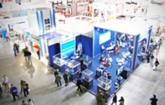Allergan, an AbbVie Company, to Share New Data Highlighting Latest Advancements in Eye Care at ARVO (Association for Research in Vision and Ophthalmology) 2021 Annual Virtual Meeting
- New analyses of Phase 3 ARTEMIS studies provide further insights on duration and biodegradation of DURYSTA™ (bimatoprost intracameral implant)
- Company will share details of patient-reported outcomes from Phase 3 GEMINI trials for AGN-190584 (pilocarpine 1.25%), a proprietary investigational presbyopia treatment
NORTH CHICAGO, Ill., April 27, 2021 /PRNewswire/ -- Allergan, an AbbVie (NYSE: ABBV) company, today announced that it will present new data, including real-world evidence, and patient-reported outcomes (PROs) for products across its eye care portfolio and pipeline at the ARVO (Association for Research in Vision and Ophthalmology) 2021 Annual Virtual Meeting (May 1-7).
"We are excited to present a range of data that will help us better understand not just how our portfolio performs in the clinic, but also the real-world experiences of our patients," said Michael R. Robinson, M.D., vice president, global therapeutic area head, eye care, AbbVie. "The diversity of our data at ARVO 2021 demonstrates how Allergan Eye Care is advancing potential treatments for patients living with a number of difficult-to-treat eye diseases including presbyopia and retina diseases such as age-related macular degeneration."
The company will present patient-reported outcomes for AGN-190584, an investigational therapy for the treatment of presbyopia. Recently the company submitted a New Drug Application (NDA) to the U.S. Food and Drug Administration based on data from the Phase 3 GEMINI 1 and GEMINI 2 clinical studies.
Data presented at the meeting will also include new analyses from the Phase 3 ARTEMIS studies examining the duration of intraocular pressure (IOP) lowering and biodegradation kinetics of DURYSTA™.
Additionally, real world data from the multicenter EXPAND study, evaluating 12-month outcomes of an investigation into a novel placement of the XEN® Gel Stent, will be presented at the meeting. The XEN® Gel Stent is currently approved only for ab-interno placement.
The ARVO 2021 Annual Virtual Meeting abstracts can be viewed at https://arvo2021.arvo.org/agenda.
Details about the presentations are as follows:
Abstract |
Presentation Details All Times EDT |
Glaucoma |
|
Extended Duration of IOP Lowering with Bimatoprost Implant in |
Paper session: Pharmacological intervention or Sunday, May 2 11:15 a.m. EDT |
A Minipump Continuous Drug Infusion Dog Model System to |
Poster session: Pharmacological intervention Monday, May 3 11:15 a.m. EDT |
Rate of Bimatoprost Implant Biodegradation in the Phase 3 |
Paper session: Clinical Studies Monday, May 3 11:15 a.m. EDT |
Corneal Endothelial Cell Loss Associated with Selective Laser |
Poster session: Ocular Blood Flow, Laser Wednesday, May 5 2:45 p.m. EDT |
A Retrospective Analysis: Visual Field Progression and Visual |
Poster session: Structure/Function, Visual Monday, May 3 4:30 p.m. EDT |
Retrospective, Multicenter, 12-month Evaluation of Ab-externo |
Poster session: Surgery and Wound Healing I Wednesday, May 5 9:00 a.m. EDT |
Presbyopia |
|
Evaluating Vision-related Reading Ability With a de Novo PRO |
Poster session: Refractive error, refraction, Thursday, May 6 11:15 a.m. EDT |
Assessing Presbyopia Impacts and Coping Behaviors with a de Novo PRO Instrument in a Phase 3 Study of AGN-190584 |
Poster session: Refractive error, refraction, Thursday, May 6 11:15 a.m. EDT |
Age-related Macular Degeneration |
|
Duration of Effect of a Single Intravitreal Injection of a |
Poster session: AMD and retinal physiology Wednesday, May 5 2:45 p.m. EDT |
Developing Methotrexate-induced Immune Tolerance in a |
Poster session: AMD and retinal physiology Wednesday, May 5 2:45 p.m. EDT |
Comparison of Visual Function in a Non-human Primate (NHP) |
Poster session: Psychophysics Friday, May 7 2:15 p.m. EDT |
Cytoprotective Effects of Brimonidine in an Induced Pluripotent |
Poster session: AMD and retinal physiology Wednesday, May 5 2:45 p.m. EDT |
Diabetic Macular Edema |
|
Profile of Vascular Permeability Factors in Aqueous Humor of |
Poster session: Diabetic macular edema Friday, May 7 2:15 p.m. EDT |
About AGN-190584
AGN-190584 is an investigational optimized formulation of pilocarpine, a cholinergic muscarinic receptor agonist, which activates muscarinic receptors located at smooth muscles such as the iris sphincter muscle and ciliary muscle and is being investigated for the treatment of presbyopia as a topical, once-daily drop delivered by a proprietary vehicle.
The proposed mechanism of action of AGN-190584 is through contraction of the iris sphincter muscle, constricting the pupil to enhance the depth of focus and improve near and intermediate visual acuity while maintaining some pupillary response to light. AGN-190584 also contracts the ciliary muscle, facilitating accommodation.
About DURYSTA™
DURYSTA™ is a prostaglandin analog indicated for the reduction of IOP in patients with OAG or OHT.
DURYSTA™ is an ophthalmic drug delivery system for a single intracameral administration of a biodegradable implant containing 10 mcg bimatoprost. DURYSTA™ should not be re-administered to an eye that received a prior DURYSTA™. DURYSTA™ is preloaded into a single-use applicator to facilitate the administration of the biodegradable implant directly into the anterior chamber of the eye.
INDICATIONS AND USAGE
DURYSTA™ (bimatoprost intracameral implant) is indicated for the reduction of intraocular pressure (IOP) in patients with open angle glaucoma (OAG) or ocular hypertension (OHT).
IMPORTANT SAFETY INFORMATION
CONTRAINDICATIONS
DURYSTA™ is contraindicated in patients with: active or suspected ocular or periocular infections; corneal endothelial cell dystrophy (e.g., Fuchs' Dystrophy); prior corneal transplantation or endothelial cell transplants (e.g., Descemet's Stripping Automated Endothelial Keratoplasty [DSAEK]); absent or ruptured posterior lens capsule, due to the risk of implant migration into the posterior segment; hypersensitivity to bimatoprost or to any other components of the product.
WARNINGS AND PRECAUTIONS
The presence of DURYSTA™ implants has been associated with corneal adverse reactions and increased risk of corneal endothelial cell loss. Administration of DURYSTA™ should be limited to a single implant per eye without retreatment. Caution should be used when prescribing DURYSTA™ in patients with limited corneal endothelial cell reserve.
DURYSTA™ should be used with caution in patients with narrow iridocorneal angles (Shaffer grade ˂ 3) or anatomical obstruction (e.g., scarring) that may prohibit settling in the inferior angle.
Macular edema, including cystoid macular edema, has been reported during treatment with ophthalmic bimatoprost, including DURYSTA™ intracameral implant. DURYSTA™ should be used with caution in aphakic patients, in pseudophakic patients with a torn posterior lens capsule, or in patients with known risk factors for macular edema.
Prostaglandin analogs, including DURYSTA™, have been reported to cause intraocular inflammation. DURYSTA™ should be used with caution in patients with active intraocular inflammation (e.g., uveitis) because the inflammation may be exacerbated.
Ophthalmic bimatoprost, including DURYSTA™ intracameral implant, has been reported to cause changes to pigmented tissues, such as increased pigmentation of the iris. Pigmentation of the iris is likely to be permanent. Patients who receive treatment should be informed of the possibility of increased pigmentation. While treatment with DURYSTA™ can be continued in patients who develop noticeably increased iris pigmentation, these patients should be examined regularly.
Intraocular surgical procedures and injections have been associated with endophthalmitis. Proper aseptic technique must always be used with administering DURYSTA™, and patients should be monitored following the administration.
ADVERSE REACTIONS
In controlled studies, the most common ocular adverse reaction reported by 27% of patients was conjunctival hyperemia. Other common adverse reactions reported in 5%-10% of patients were foreign body sensation, eye pain, photophobia, conjunctival hemorrhage, dry eye, eye irritation, intraocular pressure increased, corneal endothelial cell loss, vision blurred, iritis, and headache.
Please see link to full prescribing information
For more information about DURYSTA, visit http://www.DURYSTAhcp.com
About XEN® Gel Stent
INDICATIONS
The XEN® Glaucoma Treatment System (XEN® 45 Gel Stent preloaded into a XEN® Injector) is indicated for the management of refractory glaucomas, including cases where previous surgical treatment has failed, cases of primary open-angle glaucoma, and pseudoexfoliative or pigmentary glaucoma with open angles that are unresponsive to maximum tolerated medical therapy.
IMPORTANT SAFETY INFORMATION
CONTRAINDICATIONS
XEN® Gel Stent is contraindicated in angle-closure glaucoma where angle has not been surgically opened, previous glaucoma shunt/valve or conjunctival scarring/pathologies in the target quadrant, active inflammation, active iris neovascularization, anterior chamber intraocular lens, intraocular silicone oil, and vitreous in the anterior chamber.
WARNINGS
XEN® Gel Stent complications may include choroidal effusion, hyphema, hypotony, implant migration, implant exposure, wound leak, need for secondary surgical intervention, and intraocular surgery complications. Safety and effectiveness in neovascular, congenital, and infantile glaucoma has not been established. Avoid digital pressure following implantation of the XEN® Gel Stent to avoid the potential for implant damage.
PRECAUTIONS
Examine the XEN® Gel Stent and XEN® Injector in the operating room prior to use. Monitor intraocular pressure (IOP) postoperatively and if not adequately maintained, manage appropriately. Stop the procedure immediately if increased resistance is observed during implantation and use a new XEN® system. Safety and effectiveness of more than a single implanted XEN® Gel Stent has not been studied.
ADVERSE EVENTS
The most common postoperative adverse events included best-corrected visual acuity loss of ≥ 2 lines (≤ 30 days 15.4%; > 30 days 10.8%; 12 months 6.2%), hypotony IOP < 6 mm Hg at any time (24.6%; no clinically significant consequences were associated, no cases of persistent hypotony, and no surgical intervention was required), IOP increase ≥ 10 mm Hg from baseline (21.5%), and needling procedure (32.3%).
Click here for the full Directions for Use.
For more information about XEN, visit https://hcp.xengelstent.com/
About Allergan Eye Care
As a leader in eye care, Allergan has discovered, developed, and delivered some of the most innovative products in the industry for more than 70 years. Allergan has launched over 125 eye care products and invested billions of dollars in treatments for the most prevalent eye conditions including glaucoma, ocular surface disease, and retinal diseases such as diabetic macular edema and retinal vein occlusion.
About AbbVie
AbbVie's mission is to discover and deliver innovative medicines that solve serious health issues today and address the medical challenges of tomorrow. We strive to have a remarkable impact on people's lives across several key therapeutic areas: immunology, oncology, neuroscience, eye care, virology, women's health and gastroenterology, in addition to products and services across its Allergan Aesthetics portfolio. For more information about AbbVie, please visit us at www.abbvie.com. Follow @abbvie on Twitter, Facebook, Instagram, YouTube and LinkedIn.
Forward-Looking Statements
Some statements in this news release are, or may be considered, forward-looking statements for purposes of the Private Securities Litigation Reform Act of 1995. The words "believe," "expect," "anticipate," "project" and similar expressions, among others, generally identify forward-looking statements. AbbVie cautions that these forward-looking statements are subject to risks and uncertainties that may cause actual results to differ materially from those indicated in the forward-looking statements. Such risks and uncertainties include, but are not limited to, failure to realize the expected benefits from AbbVie's acquisition of Allergan plc ("Allergan"), failure to promptly and effectively integrate Allergan's businesses, competition from other products, challenges to intellectual property, difficulties inherent in the research and development process, adverse litigation or government action, changes to laws and regulations applicable to our industry and the impact of public health outbreaks, epidemics or pandemics, such as COVID-19. Additional information about the economic, competitive, governmental, technological and other factors that may affect AbbVie's operations is set forth in Item 1A, "Risk Factors," of AbbVie's 2020 Annual Report on Form 10-K, which has been filed with the Securities and Exchange Commission, as updated by its subsequent Quarterly Reports on Form 10-Q. AbbVie undertakes no obligation to release publicly any revisions to forward-looking statements as a result of subsequent events or developments, except as required by law.
SOURCE AbbVie

Related Links
WANT YOUR COMPANY'S NEWS FEATURED ON PRNEWSWIRE.COM?
Newsrooms &
Influencers
Digital Media
Outlets
Journalists
Opted In






Share this article